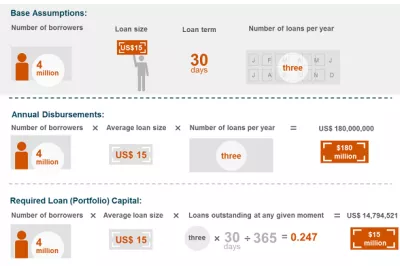An Indian Start for Digital Credit
After entering a Mumbai store, it took Shanti Ghosh less than 10 minutes to apply for a $200 loan from Axis Bank – one of India’s largest commercial banks. Less than 24 hours and a couple of reference checks later, her loan had been disbursed digitally into her Axis Bank Visa card. The card allowed her to withdraw the loan at an ATM down the road from her slum in Andheri East, a Mumbai suburb that she, her shopkeeper husband and two kids have lived in for over 10 years.
Shanti is not part of a microfinance lending group. She has no prior formal loans. She did not even visit a bank branch. The only paper work involved was the loan contract that was printed out for her to put her thumb impression on.
In an Indian environment where loans often require extensive application processes or participation in a joint liability group, this new kind of loan provided in partnership by Suvidhaa Infoserve and Axis Bank is a novelty.
If remittance be the muse of inclusion, pay on
Suvidhaa and Axis Bank are responsible for this pioneering digital credit effort. Starting out as a ticketing and bill payments platform, Suvidhaa was among the first few companies to realize the potential of domestic remittances (amounting to $11 billion in 2010-11 – up 34 percent since 2007-08).
After five years of processing and delivering domestic remittances, Suvidhaa now claims over 80,000 small shop owners as agents across India. Building on this established channel, Suvidhaa realized that the regularity of remittance transactions data is a potential substitute for low-cost credit appraisal, and has sought to build new services from this client database.

Biometric and digitization infrastructure
Leveraging data to infer creditworthiness was not going to be enough. That’s where India’s flagship unique identification program came in. Suvidhaa has rolled this product out to agents with a minimum tenure of one year as the cut-off. Most such agents have invested in a desktop computer, a printer, an Internet connection and an Aadhaar biometric reader. As a large volume remittance provider, some agents have even invested in a cash counting machine that doubles up to detect fake currency. Each agent serves several loan customers.
The Suvidhaa portal shows agents a list of eligible customers when he logs in. Customers are separately notified of a pre-approved credit limit that they can apply for, at participating agent locations. Cleverly, approved customers are mapped to designated agents following data exchange and filtering processes that take place between Suvidhaa and Axis Bank.
For customers registered with Aadhaar, the data fields can be automatically populated on the form once they provide consent. The customer then proceeds to choose one of three loan sizes ranging from $110 to $220. The agent prints a contract, explains terms and gets a physical signature from the customer before uploading a scanned copy of the form. The customer must then purchase a mandatory Axis Bank Visa card for $1.50 plus tax; the card is valid for five years, and is free to leave.
Digital disbursement and repayment
Following reference checks and internal approvals based on analysis of remittance transaction history, all of which are done remotely, the funds are disbursed within 24 hours of submitting the application. Paresh Rajde, Suvidhaa’s founding CEO, is already talking about bringing disbursal time down to minutes from hours. The card is “loaded” and the customer is free to use the funds in any manner she sees fit – withdraw cash, pay at a physical point of sale or use online. At this stage, nearly all customers are withdrawing the whole loan amount at an ATM.
The contract allows an auto-debit of the equated monthly installment from the card account each month on the due date. For Axis Bank, therefore, repayment is completely digital. For the customer, Suvidhaa schedules reminders by SMS and phone to get the customer to “top up” the card account with the monthly payment amount before the due date. Customers can visit any Suvidhaa agent, quote their card account number and pay cash to do this top-up.
Digital means low cost, low manpower, lower interest
Suvidhaa and Axis Bank are offering the lowest loan sizes and the lowest interest rates (at 21% per annum, beating microfinance) in the market for this segment of customers. There are three reasons for this.
First, the cost of funds for Axis Bank, a full-fledged commercial bank, is at least 5% lower than that of any microfinance institution. Second, Suvidhaa and Axis Bank have a remarkably good operating relationship. Most bank-business correspondent relationships in India struggle because of power asymmetries and egos. Suvidhaa and Axis Bank have achieved a clear separation of roles. Suvidhaa provides physical distribution, a loyal customer base, data, technology and operational support. Axis Bank takes the capital risk and some operational overhead. Third, as they say, execution eats strategy for breakfast. This is certainly true here.
Suvidhaa is already cooking up product variants and tweaking for improvements as it learns lessons from the early deployment. In three months from launch, it has expanded the product offering to 1,000 of its 80,000 agents. The Suvidhaa team feels it’s onto something.
This effort is at an early stage, and much remains to be learned, including how defaults will be managed, what consumer protection measures are being taken and how transparently information is being conveyed about pricing, penalties and consequences of default, for a start. But the creative efforts of Suvidhaa and Axis Bank offer a glimpse of the new kinds of services digital finance could bring to India in the years ahead. To learn more about digital credit, see CGAP’s Introduction to Digital Credit.




Comments
Innovative approach to
Innovative approach to partnering with commercial banks. It will be difficult for Microfinance to operate in a model that is disconnected with commercial banks. The right integrated model will focus on using the capital structure and leverage capabilities of a commercial bank with the delivery and scalable service capabilities of MF institutions. Credit assessment would ideally fall in the middle on the spectrum.
Excellent observations
Excellent observations Musheer. Thank you. Although in this case, the partner is a Business Correspondent rather than an MFI.
Need to know more on STP -
Need to know more on STP - Straight Through Processing use cases of Digital Lending
Add new comment